The article deals with the issues of literary tourism in Slovakia based on the material of the life and work of the personal doctor of the great Russian writer L.N. Tolstoy, the famous Tolstovian, Dusan Makovitsky. The first part contains a theoretical overview of the phenomenon of literary and cultural tourism. The second part of the article examines its advantages in the context of education, and also provides specific examples of destinations with a great tourism potential for admirers and literary researchers of L.N. Tolstoy. Authentic places and artefacts related to the life of L.N. Tolstoy and D. Makovitsky allow expanding knowledge on this topic in such fields of science as history, religious studies, cultural studies, geography, etc. The article presents new ways and opportunities for teaching and studying history, culture and literature within the framework of specific aspects of Russian-Slovak cultural relations, as well as world culture in general.
Introduction
Literary tourism is a part of cultural tourism, which is very popular because the level of cultural knowledge and heritage is more and more demanded as a result of the increasing level of education and influence of mass media. In fact, visitors of the places that are connected with famous literary masterpieces are not only readers of literary masterpieces. The visitors to famous writers' places are also those who have seen movies or dramas in theatres. The main reason why tourists decide to take part in literary tourism is the desire to have personal contact with phenomena that interests them. They can find the desired contact in museums, at cultural events, educational, thematic, and linguistic and seminar trips as well as in urban, rural, ethnic, industrial, culinary or religious spaces that are denoted as places of interest.
It is possible and necessary to distinguish high (elite) culture literary tourism from popular. Popular literary tourism is usually based on movies that inspired the audience to read a piece of literature or sometimes vice versa. The first incident of mass popular literary tourism that is still remembered by older people in Europe was connected to Karl May’s novels about Winnetou. Millions of readers and filmgoers visited places that are associated with those books or movies (Karl May Museum in Radebeul near Dresden and Plitvice Lakes in Croatia), the Plitvice Lakes national park became especially famous during the 1960s
Corresponding author’s e-mail: bencic.st@gmail.com through several Western film productions of Karl May novels. Nowadays, there are more than twenty destinations for Harry Potter fans, for example, Harry Potter World in London.
There is also an important kind of high culture literary tourism for literary “detectives”, more precisely intellectuals, specialists, researchers and all those with a high degree of knowledge in a particular field of literature. There is also a special group consisting of experts as well as high-rank executive officers (including prime ministers and presidents) who use their position and privilege to see and touch the most significant and precious artefact of cultural heritage.
The number of the mentioned “special” visitors is incomparable with those who are fans of popular culture. There are some special places in Slovakia, where the entrance to certain departments of libraries or other places are very restricted and visitors can see literary exhibits only with special permissions, for example, the Bašagić collection of Islamic manuscripts, which can be found at University Library in Bratislava. The collection was even inscribed on UNESCO's Memory of the World Register. That collection is presented to small groups of respectable persons during their visit to Bratislava.
Another very special collection of prints and manuscripts from the 16th to the 19th centuries is at the Pedagogical library in the study room of historical prints. One can find several precious textbooks, lexicons, dictionaries in the field of philosophy, religion, medicine, history, natural sciences, and linguistics there. It also includes schools’ annual reports from the 19th and the first half of the 20th century.
There are a lot of destinations and places that have ambitions to be objects of literary tourism, and one of the common rules is: some relatively unknown places and historical personalities provide unique and unknown testimonies through their orthodox documents and materials.
The following part in the paper describe and analyze the L.N. Tolstoy’s personal doctor, writer and translator Dušan Makovický (transliterated: Dushan Makovitsky, Dushan Petrovich Makovickij)
The aim of the paper is to inform educators, literary and tourism experts about the prospects of literary tourism using the relatively unknown Dušan Makovický case in compliance with practice and current worldwide requirements in the sphere of education as well as to emphasise the importance of teaching and learning out of auditoria.
The paper shows the possibilities of how to naturally arouse the interest of students and give students knowledge about the nature and dissemination of tolstoism (Russian: толстовство) as a doctrine and socioreligious movement in the late nineteenth and early twentieth centuries.
Social interdependence between literature and tourism
Literature is a stimulus to make some places immortal and to accept millions of visitors, but the mere existence of this kind of tourism industry depends on the education, professional approach and sincerity in attitude towards people who form the fundamental values for sustainability. Mostly, scholars and writers provide literary views for visitors in a natural environment. Places that were touched by literary masterpieces in the form of written and spoken thoughts, impressions, and feelings give pleasure to the visitors who admire intelligent and exceptional men and women. The natural environment evokes beauty, immortality through imagination and stimulates guests to participate in the topics and take part in organized events. Literal masterpieces are associated and identified with places and processes that form tourist worthy destinations.
The constant factors that promote literary tourism are schools and academic supports that promote literary pilgrims, heritage tourism, bookshops tours and last but not least interdisciplinary academic research.
The phenomenon of Dušan Makovický
Dušan Makovický is known among Russian speaking Tolstoyans and literary educated people around the world. Lev Nikolayevich Tolstoy and the inhabitants of Yasna Polyana called him Dusha Petrovich. He was born in Ružomberok (Austro-Hungarian Monarchy), December 10, 1866, in the family of a wealthy businessman and Slovak patriot. In 1869 his mother died. He was raised in his grandfather's family and died on March 12, 1921, also in Ružomberok (Czechoslovakia, nowadays Slovakia). He was a Slovak patriot and activist, memoirist, follower and doctor-physician, writer, translator, and public figure, mostly well known as the doctor of the Tolstoy family and peasants in Yasna Polyana. He graduated as a medical doctor from Charles University in Prague. In 1890 he became interested in Leo Tolstoy's worldview under the influence of the Kreutzer Sonata, became a follower of Tolstoy, translated his articles and works, and connected with Tolstoy's correspondence. He established a publishing house in Hungary in 1891 for the publication of the works of Leo Tolstoy and became a fervent propagandist of the Tolstoian doctrine. He published the novel “Resurrection” earlier than the Russian censored edition was published (Figure1).
Dr. Makovický visited L.N. Tolstoy in 1894, 1897 and 1901. He was also active in the dissemination of Tolstoy's works banned by censorship, collaborating with Vladimir Grigoryevich Chertkov (Влади́ мир Григо́ рьевич Чертко́ в), who printed them clandestinely in London. Vladimir Chertkov (1854–1936) was one of the most prominent Tolstoyans. In mid-November 1904 Makovytsky received a call from Sophia Tolstoy, requesting him to come to Yasnaya Polyana as the Tolstoy family's physician. On December 18, 1904 Makovický decided to live with Tolstoy in Yasnaya Polyana as his doctor. He left a huge amount of notes, published in 1938 in four volumes. He took note of everything that happened in the Tolstoy house, first of all, Tolstoy's own words. He is an author of "Yasna Polyana notes", a detailed chronicle of Yasna Polyana life from December 18, 1904, to November 28, 1910. On the night of October 27-28, 1910, he followed Tolstoy on his escape from home. He cared for the sick Tolstoy (forgetting to sleep and eat) and he was present at his death in Astapovo.
After the master's death, he stayed in Yasnaya Polyana with his family for about a decade.
Later he returned to his homeland, where he lived with his wife in difficult economic conditions. Obsessed with the idea of suicide, he hanged himself in the attic.
Acquisition of competencies based on integrated knowledge
Literary tourism tracing the life of close friends or family members related to world famous personalities provides new views and interdisciplinary knowledge to pilgrims, visitors or experts. Integrated knowledge learning is possible to associate with Content language integrated learning (CLIL), which is the most extended method of European bilingual education. That method of learning includes student’s subjects through the foreign language and literary tourism includes student’s subjects through foreign countries or places of interest. In the time of globalisation, when the world is shrinking and a man can fly around the world in two days, studying literature through literary tourism is highly attractive. Such a way of learning corresponds to several attributes that define these days. Students usually define our society as a consumer society because of the enormous consumerism that occupies their minds. A more sophisticated and more academic definition of our society is "knowledge-based society" or post-factual/post-truth" that meets the requirements of modern teaching of humanities, when both "knowledge and facts" are more than personal opinions without them.
Literary tourists can learn about orthodox material and places and acquire knowledge in different fields of study by travelling. Aside from literary and linguistic study, integrated learning in this case includes topics
104
Вестник Карагандинского университета
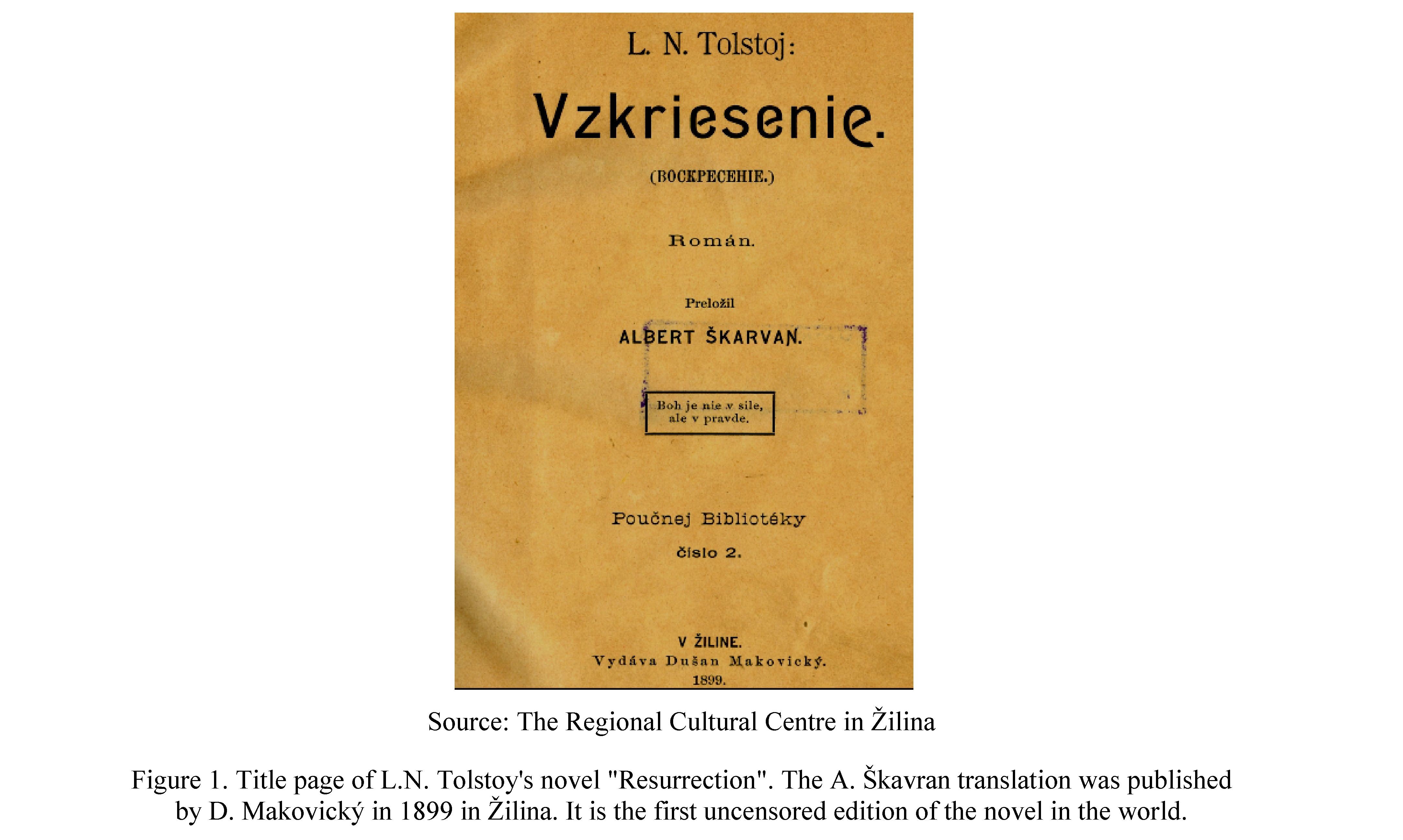
about geography, geopolitics, history of transport, international relations, world cinematography, the economy of capitalism and socialism, medicine, religion, philosophy, art, public administration, immigration, architecture, (anti)semitism, etc.
Lectures outside of university auditoria can motivate and inspire more than limited didactic aids. The object or person of the lecture should be extraordinary and unique.
Phenomenon of Dušan Makovický
Dušan Makovický’s uniqueness is based on the following historical facts:
Dušan Makovický knew L.N. Tolstoy and the people around him intimately; he was a doctor not only in their bodies, but also in their souls;
Dušan Makovický is the only detailed L.N. Tolstoy’s chronicler (called hagiographer) of his life and soul;
He wrote down in a notebook all the facts and gestures of the Tolstoy family (wife, children);
He could touch L.N. Tolstoy;
He was Tolstoy’s propagator and disseminator in Europe and vice versa: propagator of European ideas in Tolstoy mind (Nazarene movement, Protestantism);
According to L.N.Tolstoy, he was (almost) a holy man;
He is the most important witness of Tolstoy’s last days;
He provided medical treatment to poor people free of charge.
He was Tolstoy’s “state secretary” (translating, handling and processing Tolstoy’s correspondence — about 30 letters a day). Makovický communicated with tens of famous artists, scientists and historical personalities.
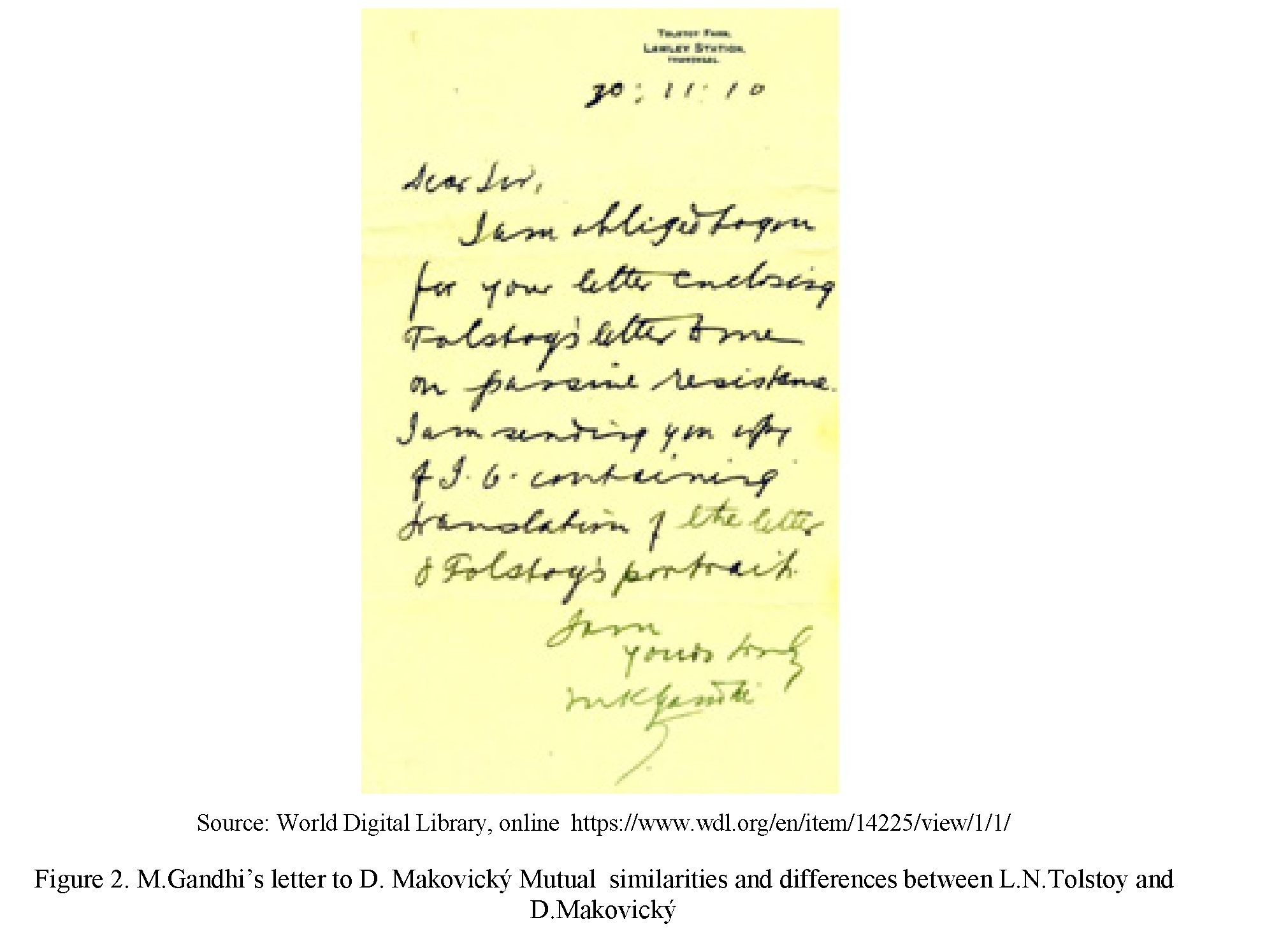 The letter was written by Mahatma Gandhi (Figure 2), addressed to Dušan Makovický in the Slovak National Library. In the letter, Gandhi thanks Makovický for his explication of Tolstoy’s views on the concept of passive resistance. The document is a testimony to the unique contacts that D. Makovický had with this eminent thinker and politician of India who represents the philosophy of nonviolence.
The letter was written by Mahatma Gandhi (Figure 2), addressed to Dušan Makovický in the Slovak National Library. In the letter, Gandhi thanks Makovický for his explication of Tolstoy’s views on the concept of passive resistance. The document is a testimony to the unique contacts that D. Makovický had with this eminent thinker and politician of India who represents the philosophy of nonviolence.
Серия «Филология». № 3(103)/2021
105
Similarities:
Opinion coincidences;
Vegetarianism;
Help for sick, oppressed and suffering people;
Interest in religious and social issues;
Interest in questions of morality;
Modesty, simplicity;
Objections to the traditional church;
Interest in the interpretation of the Bible.
Controversial issues:
The national struggle of Slovak (and other nations) in Hungary (Austro-Hungarian Monarchy) called the prison of nations.
Attitude to Jews.
Makovecký used his stay with Tolstoy to inform him about the situation in Hungary. The controversial issue between them was the national struggle of Slovaks in Hungary. Tolstoy argued that patriotism is mysticism, as it was a religion in the Middle Ages.
The Slovak national struggle supported for example Bjørnstjerne M. Bjørnson (1832–1910) a Norwegian writer who received Nobel Prize in Literature in 1903. Bjørnson fought for the liberation of the Norwegians from Swedish rule. He paid attention to the defence of oppressed European nations: Finns, Poles in Russia, Romanians, but especially Slovaks.
Tolstoy explicitly labelled Makovický as an antisemite and stated: “If there were saints, Makovický would be one of them. But since there are no saints, Makovický also has the stain, which prevents him from being perfect: anti-Semitism”. [1]
Taking into account the situation in Slovakia and Europe, it is very likely that Makovický as well as many other fighters or activists for self-determination, independence and sovereignty were in conflicts with important Jewish people who did not recognize the right of small nations to self-determination.
At the beginning of the 20th century, the topic of anti-Semitism in Europe and the USA was very frequent in “Yasnaya Polyana notes”, and even now there are articles that speculate: Was Leo Tolstoy really an anti-Semite? [2]. Yasnaya Polyana notes and other sources give a response: no, he wasn’t.
Forming new destinations of cultural tourism. Prospects of Tolstoyan places of interest in Russia
It is assumed that within the framework of cultural tourism new destinations will be created for a certain circle of admirers who are already organized on social networks or in the form of fan clubs, associations, etc. There are unique museums in the world that are rarely visited and await more effective marketing, for example, The Andy Warhol Museum of Modern Art in Slovakia (Medzilaborce). That place is connected with A.Warhol’s parents.
In our Tolstoyan topic, there is a potential for a renaissance of the Tolstoyan movement in the world that support peace practices and vegetarianism. Leading researchers of RSUTIS (Russian State University of Tourism and Service) Olga Vapnyarskaya and Tatyana Krivosheeva expect increase in cultural tourism in the Tula and Lipetsk regions and mention places that commemorate the life of L.N. Tolstoy, for example, the Museum Estate of L.N. Tolstoy and Leo Tolstoy memorial Astapovo. The supposed “enormous potential for the development of cultural tourism” depends on main and supplementary services. The researchers state that “historical and cultural experiences of some regions of the north-eastern part of the CFD (The Central Federal District) determine the high rates of tourism development and contribute to the active growth of the hotel property market as well shopping and entertainment infrastructure. Experts predict further changes in this business that will bring profit and financial success only if novel contemporary routes and developments” [3]. The name Tolstoy sounds “catchy”. It's even a good-sounding brand for literary educated people in Europe, now. Besides the healthy food, rural way of living, Tolstoy’s clothing meets the current requirements of ethno and bio shops.
Dušan Makovický destinations in Slovakia
The main destinations of the Tolstoyan movement in Slovakia are Ružomberok and Žilina, located almost in the centre of Europe. The distance from the Ukrainian border to Žilina is 334 km and to Vienna (in Slovak: Viedeň) even less (Figure 3).
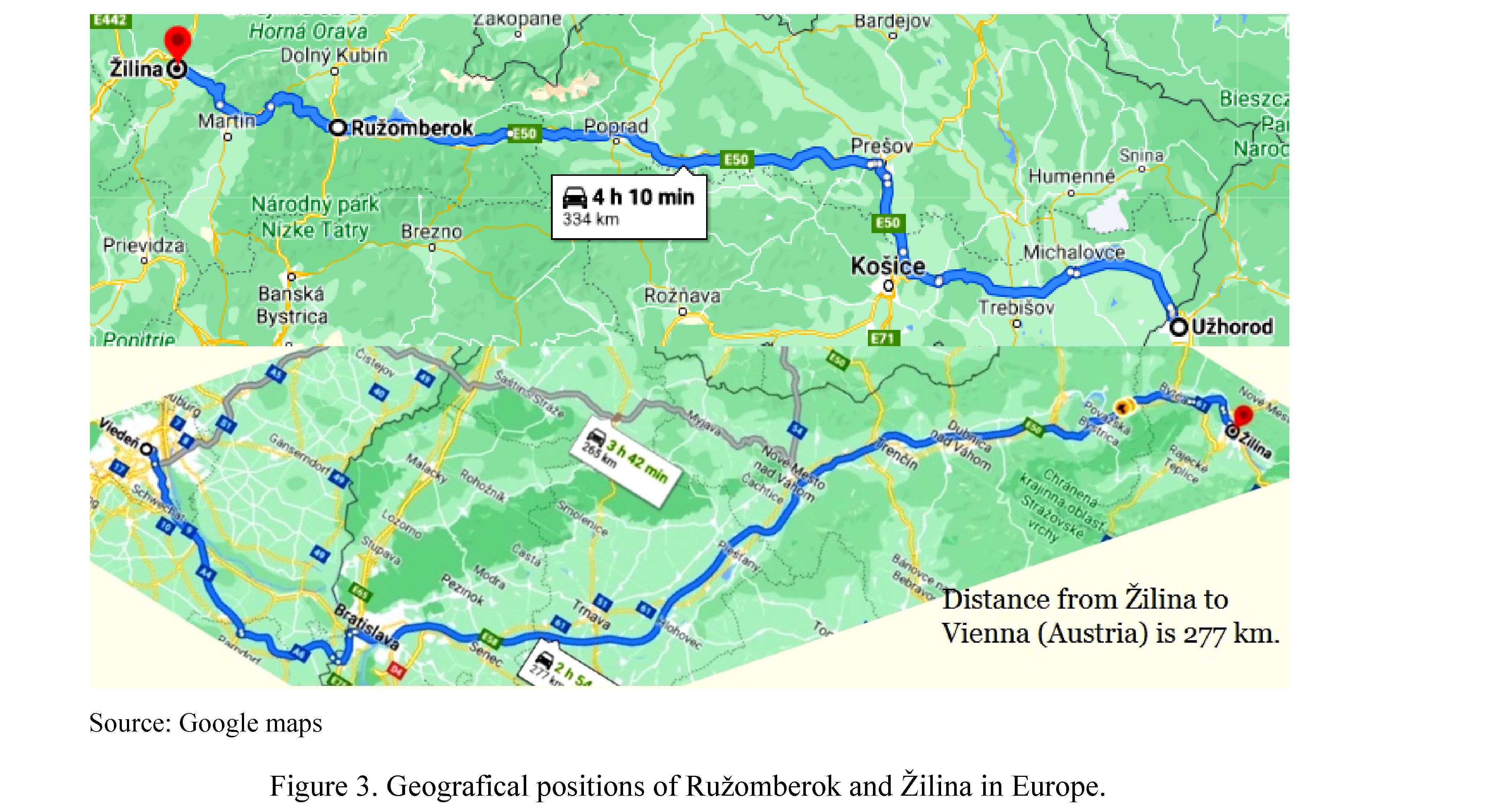
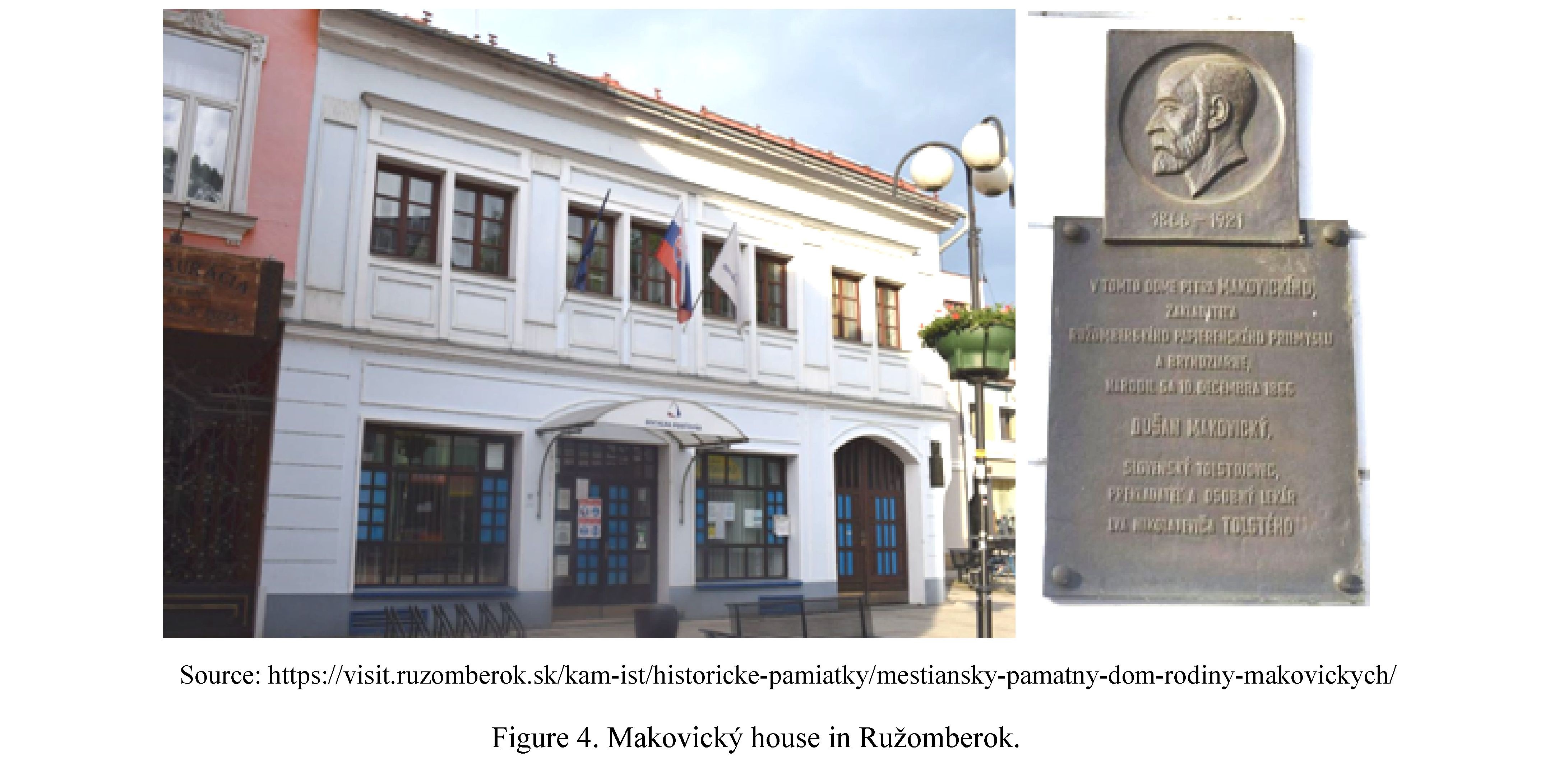
D. Makovický was born and also died in Ružomberok, which is about 70 km away from the city Žilina, where he worked and lived, too. The first written mention of the settlement in Ružomberok is from 1233 and due to location it has been a trade-market-craft centre for centuries. The burgher's memorial house of the Makovický family is located in the centre of Ružomberok. Makovický's father and uncle were important businessmen, bankers and active Slovak patriots. They fought for the self-determination rights of Slovaks and the existence of Czechoslovakia.
Dušan Makovický was a friend of the first Czechoslovakian president T.M. Masaryk.
Makovický burgher memorial house in the center of Ružomberok
It is a two-storey house that was constructed in 1867. Dušan Makovický was born in it. There is also a bronze memorial plaque on the corner of the house. At present, the building serves as a branch of the Social Insurance Agency (Fig. 4).
Серия «Филология». № 3(103)/2021
107
Another interesting place in Ružomberok is the cemetery where the tomb of the Makovický family is located (Fig. 5). Under the four-meter cross and the massive stone baptistery, members of this famous family are buried. Dušan's father, Peter Makovický, was the founder of manufacturing companies producing paper and bryndza (sheep milk cheese made mainly in Slovakia).
Almost 200 personalities of national and world importance are buried in the cemetery. There are also Jewish graves, such as Albert Einstein's first assistant Ferdinant Stark, mother of the famous Hollywood actor Peter Lorre (1904-1964), who was honoured with a star on the Hollywood Walk of Fame.
Makovický's house in Žilina
From 1894–1904 D.Makovický lived and worked in the neo-renaissance style house belonging to the Babušek family (Figure 6). The house can be visited; there is the Regional Cultural Centre. The mission of the centre in Žilina is to support the creative hobby and artistic activities of all generations, the creation of new artistic values, the implementation of cultural and social regional, national and international events. The Regional Cultural Centre in Žilina places particular emphasis on the preservation of traditional folk culture through its dissemination to the public, professional information support of folklore groups and individuals, implementation of folklore events, research and publishing activities. In the field of cultural heritage and non-professional art the aim of this institution is also to educate the public with regard to the young generation. Every year there are festivals, annual celebrations, shows, competitions, workshops, club activities, exhibitions, trainings, seminars.
108
Вестник Карагандинского университета

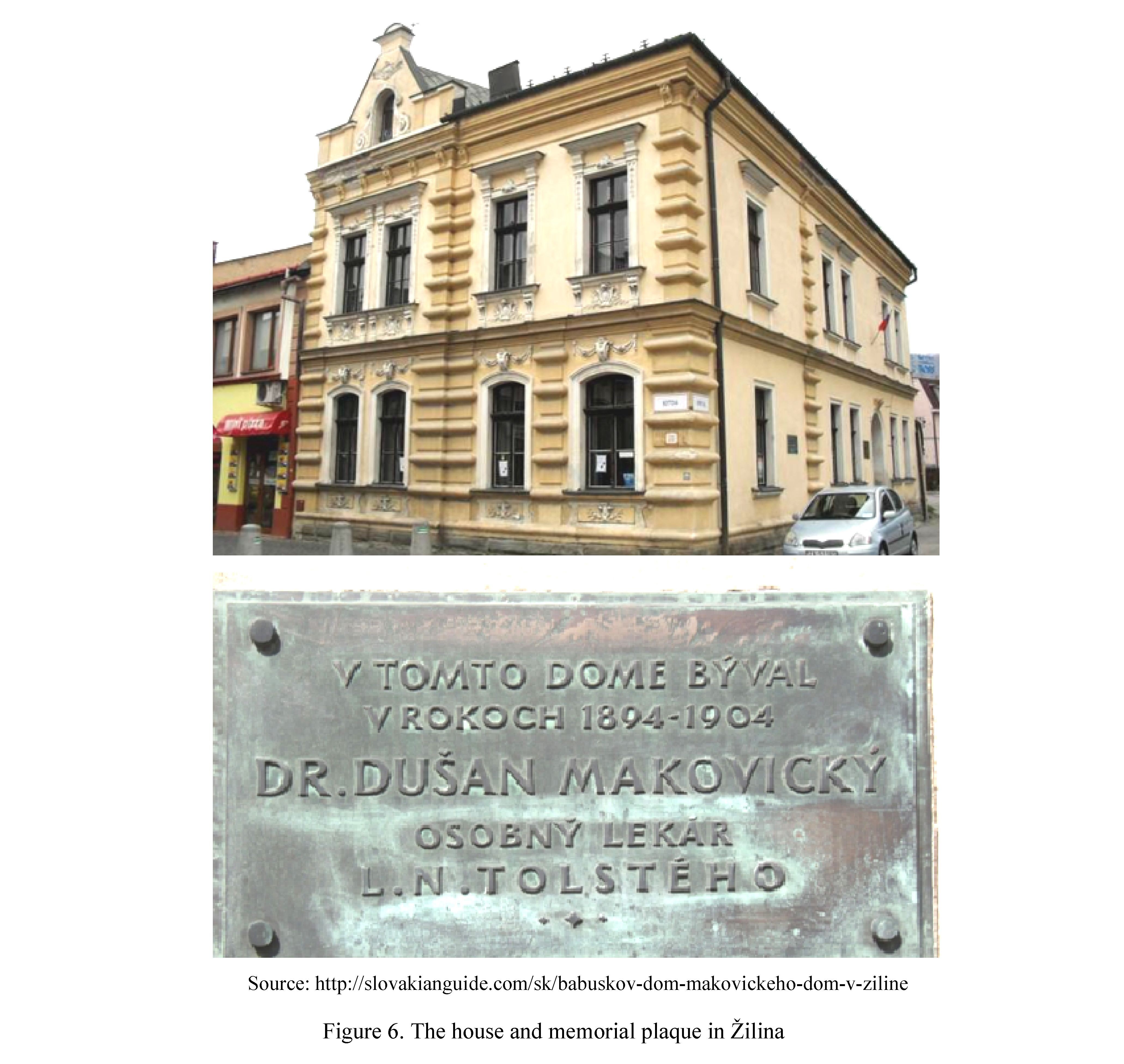
109
Conclusion
Connecting literature with literary tourism gives several valid stimuli, which have inspired scholars for ages. Giving lectures outside (rhetoric school in Rhodos), demonstrating teaching and using other didactic principles that form an educative process similar to the play (Comenius), improves interpretation, speaking and delivering of didactic material. The current labour market does not expect graduates who are “only” experts in the so-called key competencies, but the market needs the school leavers with added value [4].
Literary tourism provides the added value of wisdom within integrated learning and new ways of methodology in open space, more precisely, archaeological sites, places and premises of cultural heritage. Considering the attractive presentations of educative material, there is a threat of tendency which eliminates memory processes and learning by heart preferring only leisure. Literary tourism has to be accompanied by testing and assessment processes in the form of exercise books or other objects that are similar to Dušan Makovicky’s notebook and pencil. Before each literary trip or excursion, learners should be properly prepared as moderators, speakers, tourist guides or to act the certain role play. Less memorizing and more knowledge provide new possibilities in education thanks to transport and development in literary tourism.
Towns, buildings, documents, monuments, plaques and other objects serve as teaching aids during the demonstration of content in a natural environment. Literary tourism places are objects for more spontaneous taking photos comparing with students’ vigilance in classrooms.
Серия «Филология». № 3(103)/2021
The interpretation of symbols, coats of arms and heraldic emblems plays a special role. Literary tourism provides natural opportunities for the comprehensive teaching of humanities that enjoys public attention. The public is looking for courses such as Storytelling and Context mind because many ambitious people have understood the importance of public speaking and therefore we can name this way of literary activity - integrated learning.
References
- Sibaldi, I. (1970). Lev Tolstòj.Verona: Arnoldo Mondadori Editore [in Italian].
- Ivry, B. (2016). Was Leo Tolstoy Really an Anti-Semite? forward.com. Retrieved from https://forward.com/culture/208545/was-leo-tolstoy-really-an-anti-semite/.
- Vapnyarskaya, O.I. & Krivosheeva, T.M. (2020). Improving the Quality of Tourist Services in Central Russia. Utopía y Praxis Latinoamericana — Utopia and the practice of Latin American. 25(5), 317–327. Retrieved from https://produccioncientificaluz.org/index.php/utopia/article/view/33490.
- Pitoňáková, S. (2016). Tematika kultúrneho dedičstva v mediálnom prostredí [The topic of cultural heritage in the medial space]. Mediamatika a kultúrne dedičstvo : revue o nových médiách a kultúrnom dedičstve — Mediamatics of cultural heritage: an overview of new media of cultural heritage. Retrieved from https://fhv.uniza.sk/mkd_revue/01_2016/01_2016_pitonakova.pdf.